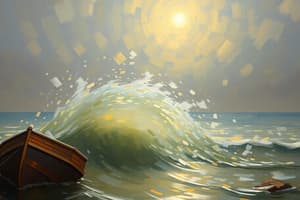Podcast
Questions and Answers
What is the formula used to calculate momentum?
What is the formula used to calculate momentum?
- Momentum = mass x velocity (correct)
- Velocity = distance / time
- Acceleration = change in velocity / time
- Force = mass x acceleration
An object can have momentum when it is at rest.
An object can have momentum when it is at rest.
False (B)
What does the term 'vector' refer to in physics?
What does the term 'vector' refer to in physics?
A physical quantity that has both magnitude and direction
The momentum of an object is zero when it is __________.
The momentum of an object is zero when it is __________.
Match the following objects with their respective masses and speeds:
Match the following objects with their respective masses and speeds:
What happens to the total momentum in a closed system when an event occurs?
What happens to the total momentum in a closed system when an event occurs?
Momentum is conserved in collisions and explosions.
Momentum is conserved in collisions and explosions.
What term describes a system not influenced by external forces?
What term describes a system not influenced by external forces?
A cannon with a mass of 96 kg fires a cannonball at _______ m/s.
A cannon with a mass of 96 kg fires a cannonball at _______ m/s.
Match the types of events with their descriptions:
Match the types of events with their descriptions:
What will happen to the momentum of the cannon when it fires a cannonball?
What will happen to the momentum of the cannon when it fires a cannonball?
The total momentum of the cannon and cannonball before firing is zero.
The total momentum of the cannon and cannonball before firing is zero.
When two trolleys collide in a closed system, what principle can be used to calculate their combined velocity after the collision?
When two trolleys collide in a closed system, what principle can be used to calculate their combined velocity after the collision?
What is momentum primarily a combination of?
What is momentum primarily a combination of?
Increasing the time taken for a collision can increase the rate of change of momentum.
Increasing the time taken for a collision can increase the rate of change of momentum.
What units are used to quantify force?
What units are used to quantify force?
The equation to calculate force when a change in momentum occurs is _______ = mass × acceleration.
The equation to calculate force when a change in momentum occurs is _______ = mass × acceleration.
Match the car safety features with their functions:
Match the car safety features with their functions:
Flashcards
Momentum
Momentum
The product of an object's mass and velocity. A combination of how much stuff is moving and how fast it is moving.
Mass
Mass
The amount of matter an object contains. Measured in kilograms (kg) or grams (g).
Velocity
Velocity
Speed of an object in a particular direction. Important! It is not just the speed. It is speed in a certain direction.
Vector
Vector
Signup and view all the flashcards
Magnitude
Magnitude
Signup and view all the flashcards
Conservation of Momentum
Conservation of Momentum
Signup and view all the flashcards
Collision
Collision
Signup and view all the flashcards
Explosion
Explosion
Signup and view all the flashcards
Closed System
Closed System
Signup and view all the flashcards
Momentum Transfer in Collisions
Momentum Transfer in Collisions
Signup and view all the flashcards
Applying Conservation of Momentum
Applying Conservation of Momentum
Signup and view all the flashcards
Momentum Equation
Momentum Equation
Signup and view all the flashcards
Rate of change of momentum
Rate of change of momentum
Signup and view all the flashcards
Force and momentum relationship
Force and momentum relationship
Signup and view all the flashcards
Momentum in a collision
Momentum in a collision
Signup and view all the flashcards
Crumple zones and safety
Crumple zones and safety
Signup and view all the flashcards
Study Notes
Momentum
- Momentum is a quantity relating to a moving object, calculated by multiplying mass and velocity.
- Momentum is a vector quantity, meaning it has both magnitude and direction.
- An object at rest has zero momentum.
- Momentum increases with increasing velocity.
- Momentum can be thought of as a combination of mass and velocity.
- Momentum helps explain some of the most important interactions in nature.
- The total momentum before an event equals the total momentum after the event (conservation of momentum).
- A closed system is not affected by external forces.
- Momentum is conserved in collisions and explosions.
- Conservation of momentum explains recoil in guns/cannons.
- Force is related to the rate of change of momentum (force = rate of change of momentum).
Calculating Momentum
- Momentum (p) = mass (m) × velocity (v)
- Units: kg m/s (kilograms meters per second)
Example Calculations
-
Lorry:
- Mass = 7,500 kg
- Velocity = 25 m/s (south)
- Momentum = 7,500 kg × 25 m/s = 187,500 kg m/s (south)
-
Ice Skater:
- Mass = 60 kg
- Velocity = 15 m/s
- Momentum = 60 kg × 15 m/s = 900 kg m/s
Conservation of Momentum
- The total momentum of a system remains the same.
Collisions
- When two objects meet and interact.
- During a collision there is a change in momentum; the force of the collision is related to the rate of change of momentum.
Explosions
- When parts of a system separate and move apart.
Example: Cannon & Cannonball
- Before firing (event), total momentum = 0 kg m/s (neither moving).
- After firing,total momentum = 0 kg m/s (momentum of cannon and cannon ball in opposite directions).
Example Calculations: Trolleys/ Explosions ( using conservation of momentum)
- Momentum is calculated for trolleys/ cannon and cannon ball before and after collision/ explosion.
- The velocity of the combined trolleys/cannon ball and cannon after collision can be calculated using conservation of momentum.
- Positive values for velocity indicate direction.
- A cannon ball of mass 4.0 kg is fired from a stationary 96 kg cannon at 120 m/s.
- The velocity of the cannon immediately after firing can be calculated using conservation of momentum.
Force and Momentum
- Force = mass × acceleration
- Force is equivalent to the rate of change of momentum
- Car safety features (seatbelts, airbags, crumple zones) increase the time taken for a collision, decreasing the rate of change of momentum and the force of the collision.
- Crumple zones are areas of a car designed to deform upon impact.
Example Calculation: Car Acceleration
- Mass = 1,500 kg
- Initial velocity = 0 m/s
- Final velocity = 30 m/s
- Time taken = 20 seconds
- Calculate the force acting on the car using the relationship force = mass × change in velocity / time taken
Studying That Suits You
Use AI to generate personalized quizzes and flashcards to suit your learning preferences.




